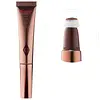What's inside
What's inside
 Key Ingredients
Key Ingredients

 Benefits
Benefits

 Concerns
Concerns

 Ingredients Side-by-side
Ingredients Side-by-side

Water
Skin ConditioningGlycerin
Humectant1,2-Hexanediol
Skin ConditioningPentylene Glycol
Skin ConditioningAlumina
AbrasiveSorbitan Olivate
EmulsifyingAmmonium Polyacryloyldimethyl Taurate
Emulsion StabilisingAmp-Acrylates/Allyl Methacrylate Copolymer
Ammonium Acryloyldimethyltaurate/Vp Copolymer
Caprylyl Glycol
EmollientEthylhexylglycerin
Skin ConditioningSaccharide Isomerate
HumectantParfum
MaskingButylene Glycol
HumectantT-Butyl Alcohol
PerfumingCamellia Sinensis Leaf Extract
AntimicrobialCentella Asiatica Extract
CleansingPhenoxyethanol
PreservativeSodium Citrate
BufferingCitric Acid
BufferingTocopherol
AntioxidantCI 77891
Cosmetic ColorantCI 77499
Cosmetic ColorantCI 77492
Cosmetic ColorantCI 77491
Cosmetic ColorantWater, Glycerin, 1,2-Hexanediol, Pentylene Glycol, Alumina, Sorbitan Olivate, Ammonium Polyacryloyldimethyl Taurate, Amp-Acrylates/Allyl Methacrylate Copolymer, Ammonium Acryloyldimethyltaurate/Vp Copolymer, Caprylyl Glycol, Ethylhexylglycerin, Saccharide Isomerate, Parfum, Butylene Glycol, T-Butyl Alcohol, Camellia Sinensis Leaf Extract, Centella Asiatica Extract, Phenoxyethanol, Sodium Citrate, Citric Acid, Tocopherol, CI 77891, CI 77499, CI 77492, CI 77491
Water
Skin ConditioningCyclopentasiloxane
EmollientIsododecane
EmollientMica
Cosmetic ColorantCetyl PEG/PPG-10/1 Dimethicone
EmulsifyingPolyglyceryl-4 Diisostearate/Polyhydroxystearate/Sebacate
EmulsifyingTriethylhexanoin
MaskingPhenylisopropyl Dimethicone
Skin ConditioningGlycerin
HumectantSilica
AbrasiveHydrogenated Starch Hydrolysate
HumectantDisteardimonium Hectorite
StabilisingHydroxyacetophenone
AntioxidantSodium Chloride
MaskingAlcohol
Antimicrobial1,2-Hexanediol
Skin ConditioningCaprylyl Glycol
EmollientTrisodium Ethylenediamine Disuccinate
Lindera Strychnifolia Root Extract
Skin ConditioningPhenoxyethanol
PreservativeEthylhexylglycerin
Skin ConditioningTitanium Dioxide
Cosmetic ColorantIron Oxides
Water, Cyclopentasiloxane, Isododecane, Mica, Cetyl PEG/PPG-10/1 Dimethicone, Polyglyceryl-4 Diisostearate/Polyhydroxystearate/Sebacate, Triethylhexanoin, Phenylisopropyl Dimethicone, Glycerin, Silica, Hydrogenated Starch Hydrolysate, Disteardimonium Hectorite, Hydroxyacetophenone, Sodium Chloride, Alcohol, 1,2-Hexanediol, Caprylyl Glycol, Trisodium Ethylenediamine Disuccinate, Lindera Strychnifolia Root Extract, Phenoxyethanol, Ethylhexylglycerin, Titanium Dioxide, Iron Oxides
 Reviews
Reviews

Ingredients Explained
These ingredients are found in both products.
Ingredients higher up in an ingredient list are typically present in a larger amount.
1,2-Hexanediol is a synthetic liquid and another multi-functional powerhouse.
It is a:
- Humectant, drawing moisture into the skin
- Emollient, helping to soften skin
- Solvent, dispersing and stabilizing formulas
- Preservative booster, enhancing the antimicrobial activity of other preservatives
Caprylyl Glycol is a humectant and emollient, meaning it attracts and preserves moisture.
It is a common ingredient in many products, especially those designed to hydrate skin. The primary benefits are retaining moisture, skin softening, and promoting a healthy skin barrier.
Though Caprylyl Glycol is an alcohol derived from fatty acids, it is not the kind that can dry out skin.
This ingredient is also used as a preservative to extend the life of products. It has slight antimicrobial properties.
Learn more about Caprylyl GlycolEthylhexylglycerin (we can't pronounce this either) is commonly used as a preservative and skin softener. It is derived from glyceryl.
You might see Ethylhexylglycerin often paired with other preservatives such as phenoxyethanol. Ethylhexylglycerin has been found to increase the effectiveness of these other preservatives.
Glycerin is already naturally found in your skin. It helps moisturize and protect your skin.
A study from 2016 found glycerin to be more effective as a humectant than AHAs and hyaluronic acid.
As a humectant, it helps the skin stay hydrated by pulling moisture to your skin. The low molecular weight of glycerin allows it to pull moisture into the deeper layers of your skin.
Hydrated skin improves your skin barrier; Your skin barrier helps protect against irritants and bacteria.
Glycerin has also been found to have antimicrobial and antiviral properties. Due to these properties, glycerin is often used in wound and burn treatments.
In cosmetics, glycerin is usually derived from plants such as soybean or palm. However, it can also be sourced from animals, such as tallow or animal fat.
This ingredient is organic, colorless, odorless, and non-toxic.
Glycerin is the name for this ingredient in American English. British English uses Glycerol/Glycerine.
Learn more about GlycerinPhenoxyethanol is a preservative that has germicide, antimicrobial, and aromatic properties. Studies show that phenoxyethanol can prevent microbial growth. By itself, it has a scent that is similar to that of a rose.
It's often used in formulations along with Caprylyl Glycol to preserve the shelf life of products.
Water. It's the most common cosmetic ingredient of all. You'll usually see it at the top of ingredient lists, meaning that it makes up the largest part of the product.
So why is it so popular? Water most often acts as a solvent - this means that it helps dissolve other ingredients into the formulation.
You'll also recognize water as that liquid we all need to stay alive. If you see this, drink a glass of water. Stay hydrated!
Learn more about Water